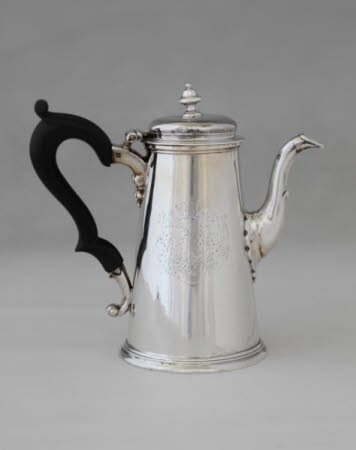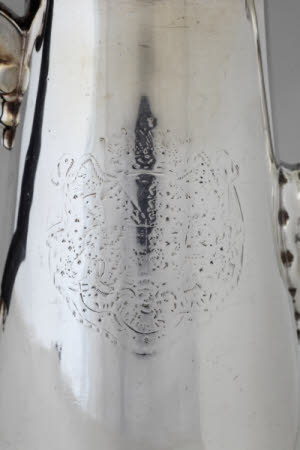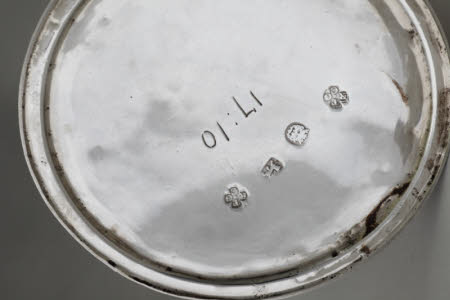Coffee pot
Richard Gurney and Thomas Cooke
Category
Silver
Date
circa 1735
Materials
Silver (probably sterling) and wood
Measurements
18.1 x 19.1 cm; 9.8 cm (Diameter)
Place of origin
London
Order this imageCollection
Ickworth, Suffolk
NT 852108
Summary
Coffee pot, probably sterling silver, by Thomas Cooke II and Richard Gurney, c.1735. The plain, tapering cylindrical pot is made of sheet seamed behind the handle. The moulded base and lip are applied and the swan-neck spout is cast in two vertical halves. The scrolling handle brackets are cast and secured to the double-scroll wooden handle by silver pins. The lid is raised to form a flattened dome and has an applied lip and bezel and a cast baluster finial. It is attached to the upper handle bracket by a five-part pin hinge. Heraldry: On the side of the pot, with the spout to the right, have been re-engraved c.1751 the quartered shield, supporters and motto of the 2nd Earl of Bristol in an ermine mantling and beneath an earl’s coronet. The engraving is very worn.
Full description
The 1st Earl’s accounts reveal that he bought coffee pots in 1696, 1733 and 1735. The first one was acquired from Edward Waldegrave, a retail goldsmith at the sign of the Anchor in Russell Street, Covent Garden who was active between 1690 and 1720.[1] It was part of a substantial purchase, amounting to 802 ounces and charged at 5s 3¼d per ounce, which indicates that the whole lot was second-hand. In 1733 Lord Bristol must have decided that his old pot was so out of date or battered that it needed replacing and one was supplied at 5s 9d per ounce by George Wickes & John Craig. As it cost £11 18s it must have weighed 38oz 8dwt and the charge per ounce indicates that it too was second-hand.[2] This pot is likely to have been for his St James’s Square house as only two years later he bought another, lighter and no doubt smaller coffee pot for £6 18s from Peter Rogers, a retail silversmith in Bury St Edmunds. This is the one still surviving and its scratchweight of 17oz 10dwt indicates a rate per ounce of 6s 11d. At last Lord Bristol had bought new, and yet the pot is not straightforward. The makers, Richard Gurney and Thomas Cooke II, had dodged the duty of 6d per ounce by inserting an old disc of silver in the base with late-seventeenth-century sterling marks, their own device stamped twice to conceal the original date letter and maker. They had quite clearly not passed on the saving to Lord Bristol which would suggest that he did not pay close attention to hallmarks. It would be interesting to know if Gurney and Cooke sent duty dodgers to the provinces routinely, perhaps relying upon the distance from London for safety from detection. Did their names also, both having East Anglian resonance if not actual connections, help them to obtain commissions in the region? This coffee pot is of the standard plain, tapering form of the late 1720s and 1730s. Gurney and Cooke marked a wide range of plate in the middle decades of the eighteenth century including a good number of coffee pots. In February, 1741 Lord Bristol made a direct purchase from Richard Gurney and Company, acquiring ‘four Gaudroned silver Dishes weighing 155 ounces 7 d weight at 7s.6d pr OZ, ingraving at 5s. each’ for £59 5s 3d. Though Lord Bristol seems to have favoured chocolate (see NT 852070), others preferred coffee and in 1724 one candidate for the vacant post of housekeeper revealed that she had left a previous employer because ‘she must have coffee every morning, and could not but at her own expence’. Lord Bristol was not inclined, however, ‘to add that article, where necessary ones already … exceed my income,’ so presumably her application was not successful.[3] James Rothwell, Decorative Arts Curator January 2021 [Adapted from James Rothwell, Silver for Entertaining: The Ickworth Collection, London 2017, cat. 15, p. 89] [1] Ambrose Heal, The London Goldsmiths, 1935, p. 51. [2] In the later 1730s Wickes was charging between 5s 6d and 5s 10d per ounce for old plate. See National Art Library, Garrard Ledgers, VAM 1 1735–40, ff. 87 (Mr Gash, 2 January 1737/8), 100 (Duchess Dowager of Norfolk, 23 October 1736) and 140 (Captain Duncombe Backwell). [3] Rev. S. A. H. Hervey, Letter-Books of John Hervey, First Earl of Bristol, 1894, vol. 2, p. 373.
Provenance
1st Earl of Bristol; by descent to the 4th Marquess of Bristol; accepted by the Treasury in lieu of death duties in 1956 and transferred to the National Trust.
Credit line
Ickworth, the Bristol Collection (National Trust)
Marks and inscriptions
Underside: Hallmarks: Marked on underside with maker’s mark ‘R G’ and ‘T C’ as a cross with a pellet between (Arthur Grimwade, London Goldsmiths 1697-1837, 1990, no. 2324), and transposed sterling lion and lion’s head erased, both pre-1697. The Gurney and Cooke marks are stamped over the previous maker’s mark and date letter, the latter possibly ‘l’ for 1688. Underside: Scratchweight: '17:10'
Makers and roles
Richard Gurney and Thomas Cooke, goldsmith


